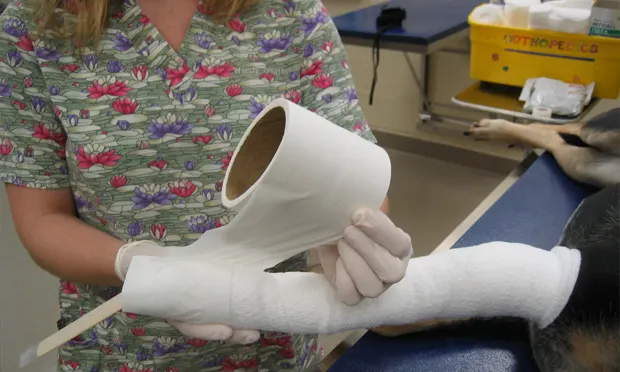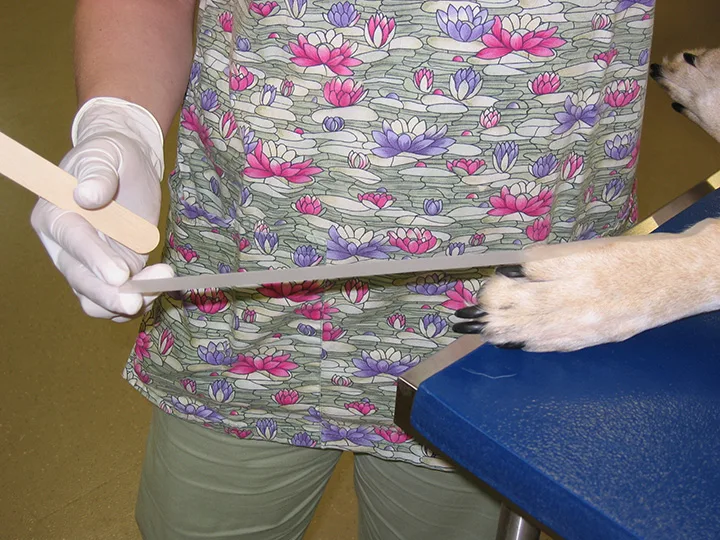Effective Casting Techniques

Casting is a commonly used technique for external coaptation or fixation in veterinary medicine and surgery. Casts are primarily used to provide rigid support of an injured limb and are typically molded around a fractured distal extremity to provide relatively motionless stability for bone fragments during the healing process. Healing occurs by secondary bony union and callus formation. As long as the joints above and below the fracture are included within the cast, bending and rotational forces are counteracted and adequate rigid stability is usually achieved. Compressive and distractive forces are not neutralized in most cases. Therefore, indications for casting include minimally displaced, closed, simple fractures of the radius, ulna, tibia, fibula, metacarpus, metatarsus, and phalanges.
Casting can be used successfully when a fracture depends on its intact paired bone to provide support (eg, fractured radius and intact ulna, isolated metacarpal/metatarsal fracture). Fracture ends should have at least 50% anatomic reduction in 2 orthogonal radiographic planes. Casting can also be used as adjunct support with internal fixation when necessary. Situations in which casts are not indicated include comminuted and significantly displaced fractures in which casting cannot neutralize forces present, fractures above the elbow or stifle, and distal radius/ulna fractures in toy or small-breed dogs.
Step-By-Step: Applying a Cast

Step 1A.
Apply 2 tape stirrups (1/2- to 1-inch adhesive tape) to opposite sides of the distal limb. The stirrups should extend from a point at or above the carpus or tarsus and to approximately 6 inches below the digits. These will be laid over the bandage at a later time to prevent distal slipping of the cast. A tongue depressor can be placed between the stirrups to facilitate separation prior to application.
PROCEDURE PEARL
A tongue depressor can be placed between the stirrups to facilitate separation prior to application.
Postapplication Care
The cast should be evaluated within 24 to 48 hours of placement. Weekly rechecks are recommended and radiographic reevaluation is typically recommended after 4 to 6 weeks. The cast can be left in place (without changing) for a maximum of 4 weeks for adult animals, as long as owners are able to keep the cast clean and dry and the animal is comfortable and using the limb well. Cast changes may be needed more frequently in young, rapidly growing animals. Logically, leaving the cast in place for as long as possible without change is best for rigid stabilization and prevention of excessive movement. If superficial abrasions or wounds were present at the time of cast placement, the first cast change should not exceed 5 to 7 days.
Potential Complications
Warn owners about complications such as dermatitis and recommend frequent (weekly) evaluations. Owners should be instructed to evaluate for abrasions created by the cast ends and for toe swelling. If any confusion exists, a card can be marked or a measurement taken to document the original distance between toenails. The owners should understand that any abrasions or increase in distance between toes requires immediate evaluation by a veterinarian.
To protect the distal portion of the cast, an empty IV bag or plastic household bag can be placed over the foot when the animal is taken outside. The bag should be removed immediately once the animal returns inside. If the cast becomes damp, a hair dryer can be used to dry the area.
If acute reluctance to bear weight, foul odor, loosening of the cast, or licking and chewing at the cast is noted, immediate (same day) evaluation is crucial. When replacing the cast, the original cast halves may be used, but particular attention to fit and integrity of the material is important. When in doubt, replace the casting material. General anesthesia is recommended for the first 2 to 4 weeks if a cast change is necessary (especially if a new cast is required).
Procedure Pearl
Because casting often requires manipulation of the fractured limb, anesthesia is strongly recommended. Superficial wounds should be clipped and cleaned and primarily covered with a nonadhesive dressing. Fractures with significant soft tissue trauma are generally not amenable to casting, unless frequent changes are done. Clip medium to long hair to ensure a snug fit of the cast.